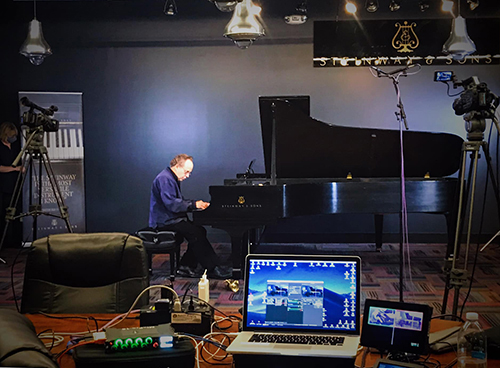by Nicholas Stevens

Artistic director and general manager Zsolt Bognár introduced the program as a “marathon” for good reason. At nearly two hours, the video, which includes an interview with Shapiro, almost matches the world-record time for that 26.2-mile race. Yet the concert, filmed by Buford T. Hedgehog Productions at the Steinway Piano Gallery in Boston Heights, demonstrated the key to a great performance in any endurance event: calibrating one’s pace to individual moments without losing sight of the overarching goal. Pacing, fortunately, is one of Shapiro’s superpowers, along with coherence of vision.
The introduction to the Sonata No. 24 in F-sharp, Op. 78 found Shapiro leaning forward in time only to step back, sustaining strong bass tones. From these hesitations emerged the downhill tumble of the movement’s faster portion. Shapiro continued to charge ahead, lose steam, teeter at precipices, and drift along, subtly pumping and slackening the gas pedal throughout. In the second movement, humor came through not just in prickly handling of small dissonances, but also in the gradual sinking of the recurring theme into repose with each appearance, as though easing ever deeper into a bedtime routine before being roused by the alternating sections.
The defining struggle at the outset of the Sonata No. 5 in c, Op. 10, No. 1, is that of leaping upward but not quite reaching the intended height. In preparing the piece, Shapiro clearly imagined Beethoven casting around the range of the keyboard for solutions, discovering ways to dramatize this for the listener. His performance churned in the middle registers and charged at the upper ones, with one attempt to rise collapsing through a portal into another world entirely. The second movement alternates between purely pianistic explorations of gesture and a stately lyricism worthy of a Mozart aria. If the first movement represents the struggle to arise and the second finds a viable walking pace, then the third feels like a sprint terminating in a plunge over a cliff. In Shapiro’s hands, the gasp-inducing, mysterious chord that signals the imminent end of the piece sounded like a revocation of the laws of gravity.
In the Sonata No. 6 in F, Shapiro maximized the contrasts between Beethovenian moods. Fulminating at the start turns to joy with delightful suddenness. The second movement’s search for safe harbor amid the fog complicates the prior movement’s sunny ending. And a struggle to direct the energy driving the third movement toward a destination leads to a collapse.
The Sonata No. 7 in D, like the other offerings, afforded Shapiro ample opportunities to explore contrasts: seldom has the key that classical composers associated with victory and glory sounded so ambivalent, and so prone to capsizing into the murky depths for such extended spans.
That words fail when it comes to Beethoven’s music is almost cliché. Even famous poets and philosophers who championed it in his lifetime introduced terms of praise that mostly do the job but feel drained of meaning by now — perhaps they felt inadequate even then. All this to say that description rarely fails for a performance of the music. However, this review will end, pointedly, with an exhortation rather than a description for Shapiro’s take on the Sonata No. 28 in A, a glowing synthesis of the entire program before it. Better to listen for yourself: the video will remain posted indefinitely.
Published on ClevelandClassical.com December 22, 2020
Click here for a printable copy of this article



